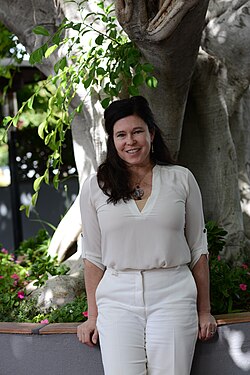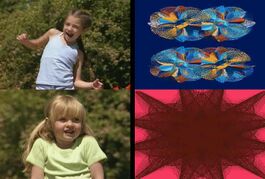Biography:Karen Pierce (scientist)
Karen Pierce Ph.D. | |
|---|---|
 Pierce in 2023 | |
| Born | Manhattan, NY |
| Education |
|
| Known for | Early Detection of Autism and Developmental Neuroscience Research |
| Spouse(s) | Eric Courchesne |
| Awards |
|
| Website | https://autism-center.ucsd.edu |
Karen Pierce is an American scientist known for her research on the early detection of autism spectrum disorder (ASD). She is a professor-in-residence[1] in the Department of Neurosciences at University of California San Diego, and co-director of the UC San Diego Autism Center of Excellence (ACE). Pierce is an advocate of early detection and treatment engagement in autism spectrum disorder (ASD), supported by evidence of the brain’s high level of plasticity during early development.[2]
Education and career
Pierce holds a bachelor’s degree in psychology from Stony Brook University, and a PhD in experimental psychology from the University of California, San Diego.
Pierce began her career as an undergraduate at Stony Brook University implementing and studying behavioral treatments for autism. She expanded on this research for her dissertation at UC San Diego under the mentorship of Laura Schreibman.[3] Pierce received additional training in neurosciences through a Career Development K01 award,[4] where she began to leverage brain imaging and eye tracking as tools for early biomarker discovery. In 2011, Pierce assembled a network of 137 pediatricians throughout San Diego to screen for autism at well-baby check-ups starting at age 12 months,[5][6][7][8] three years earlier than the average age of diagnosis.[9] This eventually formed the foundation for her Get SET Early model,[10] which provides a mechanism for the early detection and treatment referral of toddlers with ASD and to examine eye tracking and brain imaging as tools for early biomarker discovery very early in development.
In addition to grant support from the National Institute of Mental Health (NIMH) and the National Institute on Deafness and Other Communication Disorders (NIDCD), Pierce is also a recipient of grants from the Centers for Disease Control and Prevention (CDC) and the Simons Foundation.
Autism early detection research
Eye Tracking as a diagnostic tool for autism
One of Pierce’s influential areas of research is in using eye-tracking as a diagnostic and prognostic tool for ASD. In 2011, Pierce and her team reported that a subset of toddlers with ASD spent considerably more time visually fixating on dynamic geometric images, rather than social images, when compared to non-ASD toddlers.[11] Results of this initial study indicated that if a toddler visually fixated on geometric images for more than 69% of the time, the positive predictive value (PPV) that the child would be accurately diagnosed with autism by a psychologist blind to eye tracking results was 100%.[12][13] Results from this ‘Geometric Preference Test’ (GeoPref Test) were the first published eye tracking-based biomarker of a specific autism subtype. Pierce has since created additional eye tracking tests, such as those that measure attention to speech.[14][15]
Get SET Early
Pierce also developed the Get SET Early Model as a way to standardize rapid early screening, evaluation and treatment engagement within the medical community. The Get SET Early program links three critical elements: screening (S), evaluation (E), and treatment (T). The overall goal of the model is to detect ASD in a clinical setting by a child’s second birthday. In this way, children can enter treatment programs at very early ages and take advantage of neural plasticity early in life. The program is based on the collaboration of over 200 local pediatricians who screen for ASD and other developmental conditions at all 12, 18, and 24-month well baby check-ups. The model stipulates that screening should start at 12 months because should a toddler be identified as ASD and in need of treatment services, this is the youngest age currently supported by evidence-based treatment options. The model stipulates that screening should start at 12 months because should a toddler be identified as ASD and in need of treatment services, currently, this is the youngest age supported by evidence-based treatment options.
Brain imaging
Early in her career, Pierce leveraged functional magnetic resonance imaging (fMRI) as a tool to understand the brain regions and systems involved in the social challenges faced by most individuals with ASD. Many research studies have reported significant reductions in neural functional activity in the face-processing area of the brain when children and adults with ASD look at faces.[16][17] However, Pierce found that when children with ASD viewed pictures of their mother’s and other familiar faces such as sibling or neighbor, neural functional activation levels in these parts of the brain were similar to neurotypical individuals.[18] She now leverages fMRI to examine neural functional systems involved in social affective speech processing during very early development (12–36 months).
Other research
During her early career Pierce investigated the efficacy of naturalistic behavioral treatments for children with ASD, particularly Pivotal Response Treatment (PRT). Based on this work, she created both a teacher and peer training manual to support the use of PRT in a classroom setting by neurotypical students with classmates who have ASD.[19] Pierce is also an investigator for the CDC's ADDM Network and leads public health projects to determine the prevalence rates of autism in San Diego county. She is also involved in genetics and genomics research on ASD.[20][21][22]
Honors and awards
In 2023, Pierce received a MERIT Award from the National Institute of Mental Health. She has been an invited keynote speaker at many international and national conferences. In 2012, she was nominated by Time Magazine as one of the top 100 influential people for her autism early detection research.[23] Pierce was also selected to assist in the creation of a portion of the 2017 Interagency Autism Coordinating Committee’s Strategic Plan for ASD.[24] She has also won local awards, such as the San Diego Health Hero Award.
References
- ↑ "Karen Pierce | UCSD Profiles". https://profiles.ucsd.edu/karen.pierce.
- ↑ Kolb, Bryan; Harker, Allonna; Gibb, Robbin (December 2017). "Principles of plasticity in the developing brain" (in en). Developmental Medicine & Child Neurology 59 (12): 1218–1223. doi:10.1111/dmcn.13546. ISSN 0012-1622. PMID 28901550. https://onlinelibrary.wiley.com/doi/10.1111/dmcn.13546.
- ↑ "Laura Schreibman". https://psychology.ucsd.edu/people/profiles/lschreibman.html.
- ↑ "Research Career Development Awards | Research Training". https://researchtraining.nih.gov/programs/career-development.
- ↑ Pierce, Karen; Carter, Cindy; Weinfeld, Melanie; Desmond, Jamie; Hazin, Roxana; Bjork, Robert; Gallagher, Nicole (September 2011). "Detecting, Studying, and Treating Autism Early: The One-Year Well-Baby Check-Up Approach" (in en). The Journal of Pediatrics 159 (3): 458–465.e6. doi:10.1016/j.jpeds.2011.02.036. PMID 21524759.
- ↑ Park, Alice (2011-04-28). "Detecting Autism Early With a 5-Minute Questionnaire" (in en-US). Time. ISSN 0040-781X. https://healthland.time.com/2011/04/28/detecting-autism-early-%E2%80%94-how-a-5-minute-questionnaire-can-help/.
- ↑ "Autism can be diagnosed as early as 14 months, study suggests - CBS News" (in en-US). 2019-04-30. https://www.cbsnews.com/news/autism-screening-guidelines-study-suggests-diagnosis-could-start-14-months/.
- ↑ Rabin, Roni Caryn (2011-05-02). "Screening: An Autism Questionnaire at Checkup Time" (in en-US). The New York Times. ISSN 0362-4331. https://www.nytimes.com/2011/05/03/health/research/03screening.html.
- ↑ Maenner, Matthew J.; Warren, Zachary; Williams, Ashley Robinson; Amoakohene, Esther; Bakian, Amanda V.; Bilder, Deborah A.; Durkin, Maureen S.; Fitzgerald, Robert T. et al. (2023-03-24). "Prevalence and Characteristics of Autism Spectrum Disorder Among Children Aged 8 Years — Autism and Developmental Disabilities Monitoring Network, 11 Sites, United States, 2020". MMWR. Surveillance Summaries 72 (2): 1–14. doi:10.15585/mmwr.ss7202a1. ISSN 1546-0738. PMID 36952288. PMC 10042614. http://www.cdc.gov/mmwr/volumes/72/ss/ss7202a1.htm?s_cid=ss7202a1_w.
- ↑ Pierce, Karen; Gazestani, Vahid; Bacon, Elizabeth; Courchesne, Eric; Cheng, Amanda; Barnes, Cynthia Carter; Nalabolu, Srinivasa; Cha, Debra et al. (September 2021). "Get SET Early to Identify and Treatment Refer Autism Spectrum Disorder at 1 Year and Discover Factors That Influence Early Diagnosis" (in en). The Journal of Pediatrics 236: 179–188. doi:10.1016/j.jpeds.2021.04.041. PMID 33915154. https://linkinghub.elsevier.com/retrieve/pii/S0022347621003929.
- ↑ Pierce, Karen; Conant, David; Hazin, Roxana; Stoner, Richard; Desmond, Jamie (2011-01-03). "Preference for Geometric Patterns Early in Life as a Risk Factor for Autism" (in en). Archives of General Psychiatry 68 (1): 101–109. doi:10.1001/archgenpsychiatry.2010.113. ISSN 0003-990X. PMID 20819977.
- ↑ Pierce, Karen; Conant, David; Hazin, Roxana; Stoner, Richard; Desmond, Jamie (2011-01-03). "Preference for Geometric Patterns Early in Life as a Risk Factor for Autism" (in en). Archives of General Psychiatry 68 (1): 101–109. doi:10.1001/archgenpsychiatry.2010.113. ISSN 0003-990X. PMID 20819977.
- ↑ Park, Alice (2010-09-06). "Using Videos to Help Diagnose Autism in Babies" (in en-US). Time. ISSN 0040-781X. https://healthland.time.com/2010/09/06/7130/.
- ↑ Pierce, Karen; Wen, Teresa H.; Zahiri, Javad; Andreason, Charlene; Courchesne, Eric; Barnes, Cynthia C.; Lopez, Linda; Arias, Steven J. et al. (2023-02-08). "Level of Attention to Motherese Speech as an Early Marker of Autism Spectrum Disorder" (in en). JAMA Network Open 6 (2): e2255125. doi:10.1001/jamanetworkopen.2022.55125. ISSN 2574-3805. PMID 36753277. PMC 9909502. https://jamanetwork.com/journals/jamanetworkopen/fullarticle/2801102.
- ↑ "Children less attracted to 'baby talk' are more likely to have autism" (in en). 2023-02-23. https://www.kpbs.org/news/science-technology/2023/02/23/children-less-attracted-baby-talk-autism-ucsd-study.
- ↑ Pierce, K. (2001-10-01). "Face processing occurs outside the fusiform 'face area' in autism: evidence from functional MRI". Brain 124 (10): 2059–2073. doi:10.1093/brain/124.10.2059. PMID 11571222. https://academic.oup.com/brain/article-lookup/doi/10.1093/brain/124.10.2059.
- ↑ Schultz, Robert T.; Gauthier, Isabel; Klin, Ami; Fulbright, Robert K.; Anderson, Adam W.; Volkmar, Fred; Skudlarski, Pawel; Lacadie, Cheryl et al. (2000-04-01). "Abnormal Ventral Temporal Cortical Activity During Face Discrimination Among Individuals With Autism and Asperger Syndrome" (in en). Archives of General Psychiatry 57 (4): 331. doi:10.1001/archpsyc.57.4.331. ISSN 0003-990X. PMID 10768694. http://archpsyc.jamanetwork.com/article.aspx?doi=10.1001/archpsyc.57.4.331.
- ↑ Pierce, Karen; Redcay, Elizabeth (October 2008). "Fusiform Function in Children with an Autism Spectrum Disorder Is a Matter of "Who"" (in en). Biological Psychiatry 64 (7): 552–560. doi:10.1016/j.biopsych.2008.05.013. PMID 18621359.
- ↑ Pierce, Karen; Schreibman, Laura (March 1997). "Multiple Peer Use of Pivotal Response Training to Increase Social Behaviors of Classmates with Autism: Results from Trained and Untrained Peers" (in en). Journal of Applied Behavior Analysis 30 (1): 157–160. doi:10.1901/jaba.1997.30-157. PMID 9103991.
- ↑ Gazestani, Vahid H.; Pramparo, Tiziano; Nalabolu, Srinivasa; Kellman, Benjamin P.; Murray, Sarah; Lopez, Linda; Pierce, Karen; Courchesne, Eric et al. (October 2019). "A perturbed gene network containing PI3K–AKT, RAS–ERK and WNT–β-catenin pathways in leukocytes is linked to ASD genetics and symptom severity" (in en). Nature Neuroscience 22 (10): 1624–1634. doi:10.1038/s41593-019-0489-x. ISSN 1097-6256. PMID 31551593.
- ↑ "Largest autism study to take place in San Diego" (in en-US). 2016-04-21. https://fox5sandiego.com/news/health/largest-autism-study-to-take-place-in-san-diego/.
- ↑ "Autism may be caused by 'peturbed' gene network, say scientists" (in en). 2019-09-23. https://www.news-medical.net/news/20190923/Autism-may-be-caused-by-peturbed-gene-network-say-scientists.aspx.
- ↑ Staff, TIME (2012-03-29). "Should Karen Pierce be on the TIME 100?" (in en-US). Time. ISSN 0040-781X. https://content.time.com/time/specials/packages/article/0,28804,2107952_2107953_2109976,00.html.
- ↑ "2017 IACC Strategic Plan for Autism Spectrum Disorder Research | IACC". https://iacc.hhs.gov/publications/strategic-plan/2017/.
 |


